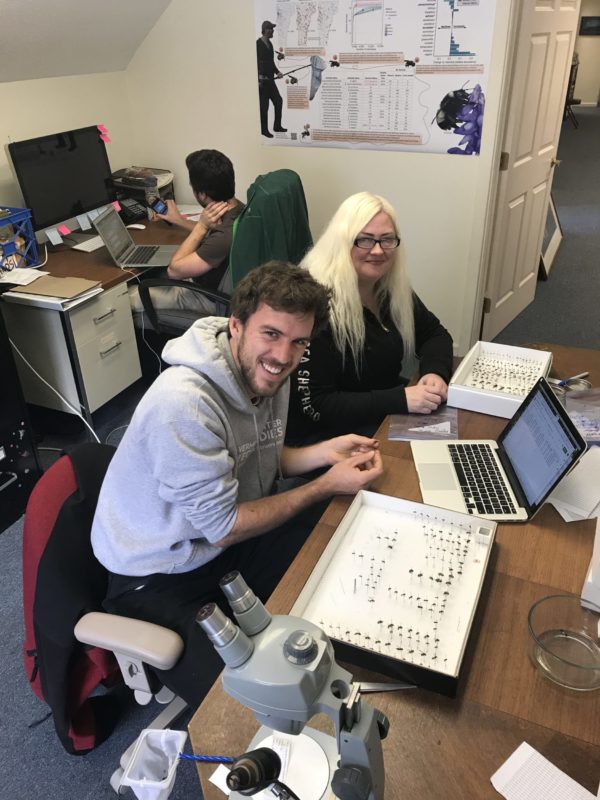Last week the Vermont Wild Bee Survey (VTBees) reached a milestone. Our project coordinator, Spencer Hardy, and our intern, Katie McGranaghan, blow dried, pinned and catalogued the last bee of 2019 to our collection and database. It was a female Mining Bee (genus Andrena), likely an Advantaged Miner Bee (A. commoda), and was the 7,680th and final bee specimen processed from our 2019 survey. This represents the largest-ever collection of bees from Vermont, and one of the broadest such efforts for the region. To be sure, this milestone is a testament to the hard work and dedication of our twelve citizen scientists, who collected 3,332 of these bees. Together, we surveyed bees across Chittenden County, from the shorelines of Lake Champlain to the lofty summit of Mount Mansfield, and from the Burlington suburbs to rural fields and forests.
Although we estimate there are more than 300 species of bees in Vermont, never had a comprehensive survey been conducted. We have evidence that some of Vermont’s native bee species are declining across their ranges, but without a statewide inventory of bee fauna, we simply can’t know how Vermont’s native bee species are faring. This is alarming given that recent research in our region is finding just how important native bees are to agriculture. For example, scientists at UVM associated with the VTBees project demonstrated that more than 90 species of wild bees visit highbush blueberry flowers on Vermont farms, contributing thousands of dollars of value to the state’s agricultural economy. And in nearby New York, Cornell scientists recently found that native bee diversity is key to better apple production.
The VTBees inaugural field season was so successful that we worried we might never get all the specimens dried and pinned. But, then along came Katie McGranaghan, a Community College of Vermont intern who spent one or two days a week at VCE throughout autumn helping Spencer. Without Katie, we would still have thousands of bees to process, and our office days wouldn’t have been nearly as fun. In addition to Katie, several volunteers are actively working to digitize UVM’s collection of Vermont bees — a huge effort which will provide invaluable information on what bees might have been buzzing around Chittenden County in the past.
Even though all the 2019 bees are now catalogued and preserved, there is still plenty of work to be done. Only 2,762 of our 9,008 total records from 2019 (specimens + photographs and sight records) are identified to species. We know which genera each individual belongs to, but identifying each specimen to species can be very tricky. Thankfully, a few bee experts have offered to help us. In January, Spencer Hardy will travel to Maryland, accompanied by thousands of bee specimens, to visit Sam Droege at the Native Bee Inventory and Monitoring Lab at the USGS Patuxent Wildlife Research Center.
While most people recognize the introduced Honey Bees (Apis mellifera) and our native Bumblebees (Bombus), these make up only a small fraction of the bees found in Vermont. During this past summer’s survey, Bumblebees were the second most abundant genus recorded, though this group may be overrepresented, since they are large and easily recognized. The other two genera in our top three — Lasioglossum and Ceratina — are small and easily overlooked, yet ubiquitous. Overall, our current tally stands at 35 different bee genera, including two that are new discoveries for Vermont.
Among those specimens that we have so far identified to species, there are a number of surprises and some interesting trends. Even with 9,008 records, there are at least 14 species represented by only a single specimen, suggesting that many more species in the state still await discovery. And tentatively, we’ve found 21 native bee species that had never before been documented in Vermont. We don’t even know the bees in our own backyard! The Vermont Wild Bee Survey is working to change that, and there can be no doubt that many exciting discoveries lie ahead.


Curious whether there are still plans to expand the wild bee survey to all of Vermont next year as originally planned.
Hi Steve,
Yes, we still plan to expand statewide in 2020. For details you should contact Kent McFarland of VCE.